 During a bout of procrastination, I came across this post on Serious Eats about making udon from an translated-to-English Japanese cookbook classic, Japanese Cooking: A Simple Art by Shizuo Tsuji. You know this is a classic, since the original forward for it was written by M.F.K. Fisher! Anyway, the author of the Serious Eats post gets quite excited about the instructions in the recipe (which apparently calls for egg yolks...more about this later) saying to knead the dough until it's the texture of an earlobe.
During a bout of procrastination, I came across this post on Serious Eats about making udon from an translated-to-English Japanese cookbook classic, Japanese Cooking: A Simple Art by Shizuo Tsuji. You know this is a classic, since the original forward for it was written by M.F.K. Fisher! Anyway, the author of the Serious Eats post gets quite excited about the instructions in the recipe (which apparently calls for egg yolks...more about this later) saying to knead the dough until it's the texture of an earlobe.
Actually, the earlobe (mimitabu 耳たぶ) is used quite commonly in Japanese cooking. What? you say? Well...here's how.
Filed under:
japanese offbeat
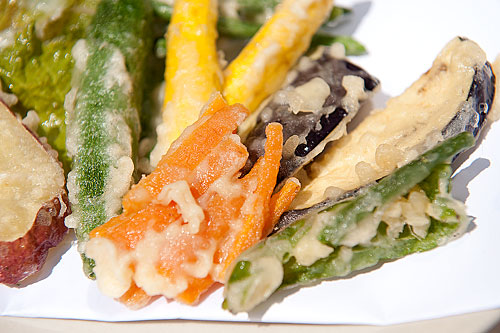
I've never really been good at making tempura, the quintessential Japanese deep fried dish. My mother's tempura has always been terrific - crispy, light, and not greasy at all. So, taking advantage of her extended vacation here this year, I drilled her properly on how she makes tempura.
Her method does not rely on special tempura flour (cheap in Japan but expensive or hard to get a hold of elsewhere), or other recently touted additions like vodka or other high-alcohol liquor, so anyone should be able to do it. Just follow the key points listed below.
Filed under:
japanese vegetables vegetarian washoku
I've updated this very popular article a little bit and pushed it up from the archives, since it is the season for cold noodles now. I'll also have a followup recipe soon for the perfect accompaniment to zaru soba. Originally published in May 2007.
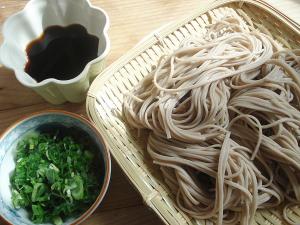
Most of Japan gets very hot and humid in the summer. To combat the heat, a number of dishes meant to be eaten cold have been developed. One of the main cold summer dishes is cold noodles.
Soba noodles, made of soba (buckwheat), are available all year round but are really popular when the heat turns unbearable. As with other cold noodles, they are prepared in a way that may seem strange if you're used to pasta and other Western-style noodles. Unlike pasta, most Japanese noodles, including soba, are rinsed rather vigorously in cold running water. This not only cools them down but gets rid of excess starch, which adversely affects the flavor of the noodles. Many recipes written in English omit this critical rinsing step: you don't just plunge it in cold water, as many directions incorrectly state, but you actively wash the noodles. Once you've done this once, you will definitely notice the difference. I've given detailed instructions for this procedure below.
Dipped into a properly made sauce or soba tsuyu, with plenty of spicy condiments or yakumi, there's nothing more refreshing to eat on a hot summer evening.
Filed under:
basics japanese summer noodles soba
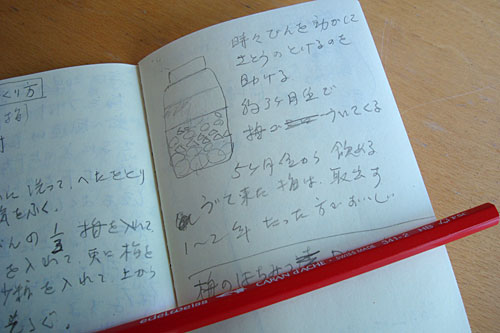
Since so many people liked my mom's umeboshi recipe, here are two more recipes using ume plums from her. She doesn't have photos for these, so I've taken a picture of her notes, with a little illustration she did of how to layer the ume and sugar for the umeshu (plum wine).
Filed under:
drink fruit japanese preserves and pickles summer mom's recipes
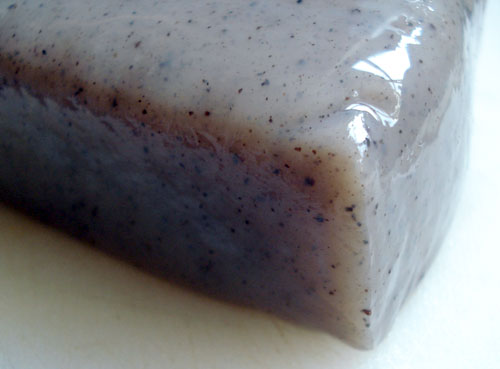
From the archives. For some reason I've been getting several email questions about konnyaku recently, so here is my definitive (I hope) guide to preparing konnyaku and konnyaku noodles, or shirataki. Originally published in January 2007.
The quintessential Japanese foods that (may) help you lose weight, are konnyaku and shirataki. Both are made from the same substance, the corm of the konnyaku or konjac plant. Shirataki is also known as konnyaku noodles, to further confuse things, but I prefer the original name which means "white waterfall". It's basically konnyaku shaped like long thin noodles.
Filed under:
japanese lighter weightloss diet ingredients low-carb
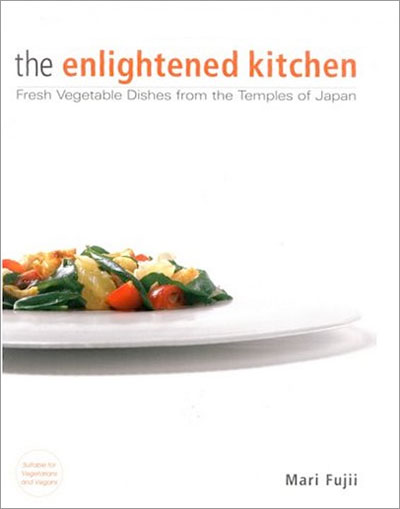
A review of The Enlightened Kitchen: Fresh Vegetable Dishes from the Temples of Japan by Mari Fujii, a beautifully presented, easy introduction to the world of shojin ryori (or shoujin ryouri 精進料理), the highly refined vegan cuisine developed by Buddhist monks in Japan. One copy of this great book is up for grabs!
Filed under:
books and media japanese vegetarian vegan

We still haven't found a house to buy (though we may getting close), and due to the way things work in France, we are probably going to be nomads for at least 4 more months even if we put in an offer for a place tomorrow. I've gotten more used to cooking in tiny holiday home kitchens, but I'm still not up to anything too complicated - or in other words anything that requires the use of more than 2 burners at a time.
Fortunately it's now summer, which means lighter, less complicated meals anyway. This salad, which can be a meal on its own, a starter or a light side dish, features sweet salad onions (spring is the season for them, at least around these parts), sliced paper-thin and refreshed in ice cold water. The tart dressing features umeboshi (pickled plums) and uses no oil, so this is an almost fat-free, fairly low calorie dish, that's vegan to boot.
Filed under:
japanese lighter vegetarian summer noodles vegan salad soba
Submitted by maki on 14 May, 2009 - 18:43

This is a continuation of my series on Japanese food shopping, and frugal eating, in Europe. Previously I visited Paris and Düsseldorf's Japantown.
Lyon, the third largest city in France and arguably the second most important one after Paris, does not have a large Japanese expat or immigrant population. However, there are some Japanese corporations that have factories or offices in the area, not to mention a large university population. So in terms of the availability of Japanese groceries in France, it ranks second to Paris, although it trails behind by a large margin.
It also gives me a chance to talk a bit about where exactly you can find Japanese ingredients, regardless of the town you're in.
Type:
feature Filed under:
japanese ingredients shopping france
(The survey is now closed. Thank you for everyone who took the time to comment/answer!)
In connection with a project I'm working on at the moment, I'd like to take a short 5-question survey of Just Bento and Just Hungry readers.
I assume you are here because you have at least some interest in Japanese food and cooking. My questions are as follows.
Filed under:
japanese ingredients surveys
Pages